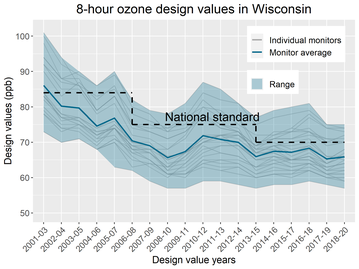Wisconsin Air Quality Report Shows Improvement

The Wisconsin Department of Natural Resources (DNR) today announced the newly released 2021 Wisconsin Air Quality Trends report shows Wisconsin’s air quality continues to improve, building on a nearly 20-year trend.
According to the annual report, concentrations of monitored pollutants are decreasing throughout the state, and a majority of the state is meeting all federal air quality standards.
This year’s report includes official state monitoring data through 2020 for air pollutants regulated under the federal Clean Air Act, including ground-level ozone, particle pollution, sulfur dioxide, nitrogen dioxide and carbon monoxide.
“Based on extensive health studies, the Environmental Protection Agency (EPA) establishes specific air quality standards for each pollutant,” said Katie Praedel, DNR Air Monitoring Section Chief. “The DNR’s job is to measure pollutants around the state to determine if concentrations are below the health-based federal standards.”
 |
The most recent data shows statewide reductions in ozone values, including along Wisconsin’s Lake Michigan shoreline, an area historically impacted by elevated ozone concentrations. While nine Lake Michigan shoreline counties are not currently meeting national standards, the region has seen a 25% average reduction in ozone concentrations since 2001.
Wisconsin has also seen dramatic reductions from industrial sources of air pollutants. Since 2002, industrial source emissions of volatile organic compounds (VOCs) have dropped 39%. VOCs react in the air to form ozone, so this decline in emissions is very important to meeting state ozone goals. Emissions of sulfur dioxide have decreased 92%.
The DNR attributes the overall pollutant concentration decrease to the implementation of a variety of federal and state pollution control programs. The greatest reductions are a direct result of cleaner burning and more efficient fuel combustion from highway vehicles and electric utilities.
In addition, fine particle concentrations have decreased 35% since 2002, and the entire state is meeting the federal standard, which was not the case a decade ago.
“We will continue working with our local, state and federal partners, along with several research organizations to ensure continued improved air quality trends, especially along our lakeshore and where groups are disproportionately impacted by air pollution,” said Gail Good, DNR Air Program Director.
During the Spring 2020 timeframe of Gov. Tony Evers’ COVID-19 “Safer at Home” executive orders, preliminary data from the Milwaukee monitoring site along I-94 on College Avenue showed a reduction in daily peak concentrations of nitrogen dioxide and carbon monoxide associated with rush hour traffic.
A snapshot data analysis suggests that nitrogen dioxide concentrations dropped by an additional 14% for the period following the “Safer at Home” order (enacted March 25, 2020) relative to a similar 2019 timeframe. However, emissions from vehicles are only one factor contributing to air quality.
Emissions from other sectors, such as industry, power generation and non-road mobile sources are also important contributors that did not experience emissions declines during the “Safer at Home” order. Other factors like temperature and wildfire smoke impact pollutant concentrations as well. A more detailed analysis of all factors is needed to specifically quantify how “Safer at Home” orders may have impacted air quality.
The 2021 Air Quality Trends Report, along with previous reports, are available on the DNR’s Air Quality webpage. Current Wisconsin air quality conditions can be found on the Wisconsin Air Quality Monitoring data webpage.





